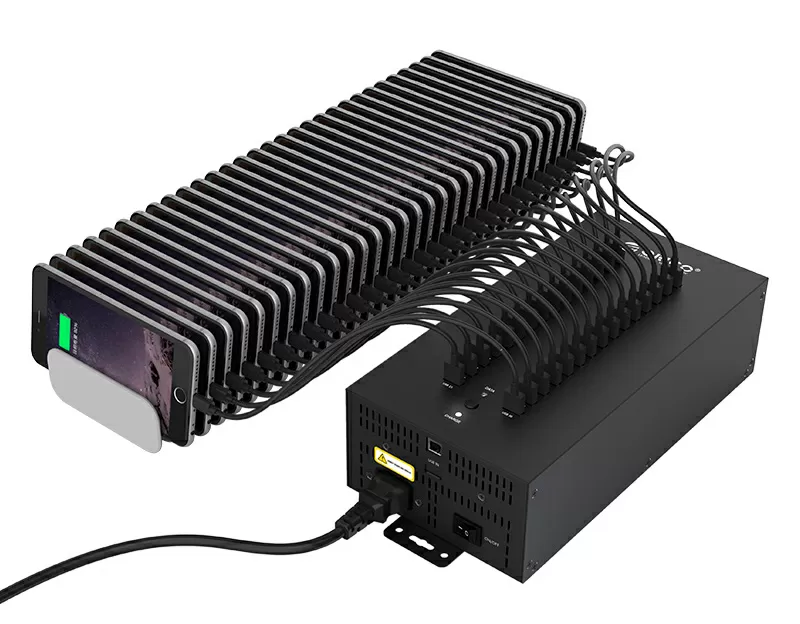Choosing an industrial USB hub on the example of Orico products
Mobile phone charging terminals at airports, electronic storage rooms in supermarkets, vending machines selling chocolates in shopping centers... you will be surprised how many modern devices use dozens of USB connections for their work. Somewhere you need to open the electronic lock when the customer receives the parcel at the pick-up point, somewhere you need to control the servo, and somewhere you need to simultaneously program a large number of electronic tokens. As a rule, industrial computers have 2-4 USB ports, often even USB 2.0, and choosing a USB hub for them, you should keep in mind that its cost may be more than half the price of the entire project.

Today we will look at the main criteria for choosing industrial USB hubs using the example of products from the Chinese company Orico. This manufacturer has literally occupied the niche of USB devices, and produces everything that connects via USB: from a docking station for hard drives to various cables for mobile phones. As a rule, such a wide range of models is not welcomed by conservative integrators who choose a supplier on the principle of "do one thing, but do it well", but all doubts disappear as soon as you pick up a 32-port USB hub in a solid steel case with a built-in 300-Watt power supply.
What is important when choosing industrial USB hubs?
First of all, you need to understand that the USB hub transmits the signal and power via a thin cable that runs through the entire body of a vending machine or other device and can go out with contacts to the outside, where snow, rain, mud and people are! So, picking up a USB hub to the project, you need to lay a supply by the number of ports in case of breakage or damage: if the USB interface is available to the outsider (for example, we are talking about devices charging phones), the backup port must be at least 20%, and if USB is used internally, e.g. for work with tokens, it is enough for stock and 10%.
Keep in mind that not all USB ports can transmit data. For example, in 12-port USB hubs, you can find 2 USB 3.0 ports, 6 USB 2.0 ports, and 4 "power only" ports. If the design provides for switching the operating mode, for example, from "power only" to "power + data", it is usually carried out by a button on the case. No software or remote control is required.
The maximum current on each of the ports, or the so-called power consumption of the device. Many industrial splitters are not designed to have all their resources constantly used at 100%. Therefore, the total power of all USB ports may be higher than the capacity of the USB hub power supply. If there is a lack of power, the entire hub can be disconnected from overload, which will cast doubt on the feasibility of using it. From this point of view, the 30-port Orico IH30P-U2-BK hub is interesting - each of the USB 2.0 ports can have a current of up to 2 Amps, and the power supply unit impresses with its power of 300 watts. For comparison, the power consumption of a regular USB 2.0 port is 500 mA, which is 4 times less.
With USB 3.0, the power situation is even better - the Orico a3h13p2 aluminum hub has 15 third-generation ports, of which 13 operate in "data transfer" mode and have a current of up to 1000 mA, and 2 are used only for power and their current is as much as 2400 mA, almost 3 times more than the limit of a standard USB 3.0 port.
Short-circuit and overload protection should function in such a way as to disable only the problem port and not affect the operation of the others. In General, since we remembered about protection, let's list the main ones:- From electrostatic voltage
- Against short circuit
- Against overload
- From overheating
Commissioning will become much easier if each USB port has an led indicator of its activity. At a minimum, if the hub has the "power only" and "power + data" modes, then you should see the type of current connection on the device itself, and not use the poke method. Of the devices we are considering, only the Orico A3H13P2 has an indication of each port.
Depending on the power, the USB switch can have built-in or external power supplies. The first is preferable in terms of reliability and quality of power supply, the second is easier to replace in the field. DIN rail mounting devices are often supplied without power supplies at all and have terminal inputs for connecting to a DC bus that is wound up in the distribution Cabinet.

The distance between the USB ports will determine whether you can install large devices such as a 4G modem directly into the hub, or whether you will need to use an extension cord. When buying a hub for USB miners, do not forget that they need active cooling, so one of the ports can be allocated for a USB fan.
Every chip, every capacitor in a USB hub is a potential point of failure, no matter how good they are. Inside your home USB hubs, you'll find one controller, and if you're lucky, an LC power filter with bare - shell or electrolytic capacitors. Inside professional USB hubs, you will see that each port has its own power filter, and switch chips serve no more than 4 ports, or even can be individual for each physical interface. The 30-port Orrico IH 30 PU 2-BK uses 4-port Terminus FE1.1 s switches, while the capacitors are only solid - state.
The USB hub enclosure can be mounted on a DIN rail or a 19-inch telecommunications rack, or both at the same time. The scope of application of the device depends on the design of the case, including resistance to low or high temperatures, dust/moisture protection, and access to work in aggressive and fire-hazardous areas. The Orico USB hubs we are considering do not belong to any of these types - the 30-port IH30PU2-BK uses a simple metal case for horizontal installation, even without rubber legs, but complete with wall mounting brackets. The more compact 15-port A3H13P2 already has an aluminum body, while the 8-port P12-U3-BK is completely plastic.
Orico P12-U3-BK clearly demonstrates why plastic hub cases are not held in high esteem: in this hub, the manufacturer for some reason decided to add a mechanical shutdown of every three ports by installing push buttons for this purpose. So they are pressed with a Bang, and they do not want to do push-UPS, but it is only necessary to poke the USB cable through the ports, as something straightens in the case and the switches work again. Whatever one may say, but the rigidity of the structure is not here, and the savings on materials do not justify themselves.
Software compatibility
All industrial USB switches do not require the installation of any drivers for their operation, so they are compatible with any operating systems based on Windows and Linux.
The interface speed
In General, there are very few options for using USB hubs where speed matters. Usually, these are devices associated with transmitting and processing photos. For this reason, most USB hubs still use the USB 2.0 interface, although they can connect to the computer via USB 3.1 Gen1.
Price
In fact, the market for industrial switches is so narrow that the cost here is determined only by the desire of the seller, and as a rule, is very disconnected from reality. It may not depend on the number of ports, power characteristics, or interface speed. As a rule, mounting on a DIN rail and having a bundle of certificates can raise the price by 1.5-2 times.
|
|
Number of ports | Current per port, mA | Power Capacity, Wt | Din or Rack mount | Price, $ | Price per port, $ | Price per USB Wt, $ |
| Moxa Uport 407 | 7 | 500 | 17,5 | DIN | 292 | 41,7 | 16,7 |
| Conel BB-UHR207 | 7 | 500 | 17,5 | DIN | 408 | 58,28 |
23,3 |
| Titan HUB-1600i-RM | 16 | 500 | 40 | Rack | 367 | 22,93 | 9,2 |
| Orico IH30P-U2-BK | 30 | 2000 | 300 | No | 294 | 9,8 | 0,98 |
| Orico A3H13P2 |
13 + 2 |
1000, 2400 |
89 |
No |
118 | 8,42 | 1,3 |
| Orico P12-U3-BK |
9 + 3 |
1000, 2400 |
81 |
No |
70 | 5,8 | 0,9 |
Orico also has cheaper versions of the hubs in question:
- A3H4 - 4 ports USB 3.0, 45$
- A3H7 - 7 ports USB 3.0, 54$
- A3H10 - 10 ports USB 3.0, 84$
- P10 - 10 ports USB 3.0, 102$
Conclusions
USB hubs are the simplest active device in industrial IT equipment, and you can and should save money when choosing them without falling to the level of cheap consumer devices.
The Orico model range completely lacks USB hubs with DIN-rail mounting, which may repel manufacturers and integrators who strive for monobrandness in all their projects, but for tasks such as mass charging of smartphones, as well as for mining farms or automatic storage cameras, Orico IH30P-U2-BK is the best choice both for the price per device, for the price per port, and for the price per USB-Watt.
Michael Degtjarev (aka LIKE OFF)
08/08.2018









